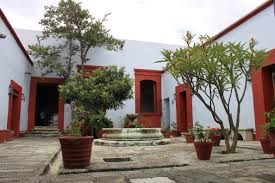Day 70: Thursday, March 12
Our final day of classes. Saying good-bye to ICO was definitely tear-jerking, but I am comforted in knowing that I will return someday.
That night my program had our final good-bye dinner at the beautiful Restaurante Catedral. My housemate and I were so excited about this semi-formal group event that we spent a good chunk of time prepping out hair, makeup, and outfits.
Speaking of hair, I got mine done in Oaxaca on this day! My ends were in need of some trimming, but I was afraid to let a hairstylist other than someone my mom suggested touch my hair. I was also worried that the hairstylists wouldn’t be used to dealing with hair as curly as mine. Most of the Oaxaquenos I met had very straight or nearly straight hair and were always so intrigued by my curls. (As usual I had to explain to dozens of people that, «no, I don’t want you to pet my head or run your hands throughout my hair without my permission.») But after about 15 minutes of interrogating my host mom, she finally convinced me to let Pedro trim my ends. She drove me to his salon, just a few blocks from her house, and Pedro and his assistant got to work. They washed and cut my hair, then convinced me to let him shape my hair as well. I was left with a curly bob and was absolutely in love with his work! But of course, that wasn’t the end of this adventure. I was also convinced to let him straighten my hair. I hadn’t put heat on my hair in many months, and anyone who knows me knows that I take the health of my hair very, very seriously. But, alas, Pedro worked his magic and I went from scraggly split ends to a cute curly bob to straight hair laid to the gawds. I also learned that, while most Oaxaquenos hair may not be as curly as mine, people with curly hair get treatments to straighten their hair and people with straight hair get treatments to make their hair more wavy. This is all so similar to my experiences in the U.S.
After we finished getting ready we arrived to the restaurant. (and were about 30 minutes late because of all the time we spent dressing to the nines [and waiting to catch the bus of course]) The food was absolutely delicious, Restaurante Catedral is beautiful, and the company was wonderful, as well. My house mate and I were surprised to find out that we were the only ones dressed up, but I believe it is always better to be over than under dressed. 😉
After dinner Professor Lucy joined us at Txalaparta. Unfortunately the Bachata instructor couldn’t make it that night, but we did enjoy salsa classes. At Txala we ran into some of the artists from Espacio Zapata and some of their friends, as well. I spent the night dancing to cumbia and hip-hop music among new and old friends.
Day 71: Friday, March 13
Friday!!!!! We had no assignments, no excursions, no obligations what so ever. The rainy season was beginning in Oaxaca towards the end of our trip, so it rained on and off on Friday. I spent the day walking around the streets, taking in the beauty of this city. I also began packing. Fortunately, my tummy loved Oaxaca so I had plenty of pepto-bismol and tums leftover. Also, a student that went to Oaxaca two years before me had advised that I under-pack my suitcase so that I’ll have plenty of space to bring things back. That was such great advice, because after separating things that I would be bringing home from things that I would be leaving, I was literally at the 25 kilogram weight limit for flying.
Later that night I went to Biznaga, a restaurant in El Centro, with some students from my program and their intercambios. The food was pretty good. After dinner we headed to Txalaparta. It was their anniversary so there was a cover and they gave us fun masks and balloons and stuff. The club was super crowded. Although I enjoyed spending time with friends, I still felt a bit of sadness from knowing that my last hours in Oaxaca were approaching rapidly.
Day 72: Saturday, March 14
Saturday. I finished packing. This day was so sad. I cried at the thought of having to leave Oaxaca. The gray skies and light mist that covered this usually vibrant city did nothing to help my sadness. On the bright side, I ran into Saul later that night. He definitely brought some much needed joy into my life. We went to a few bars and danced, spoke with old and new friends, and enjoyed our last few moments together (at least until I return next year). I love my friends and Oaxaca and eagerly await our reunion.
Day 73: Sunday, March 15
The departure. I headed to the airport and slept through all the flights. It was very uneventful because I was so tired. But then I finally saw my family and felt a great swelling of happiness in my heart.
My 73 adventures have ended.






































